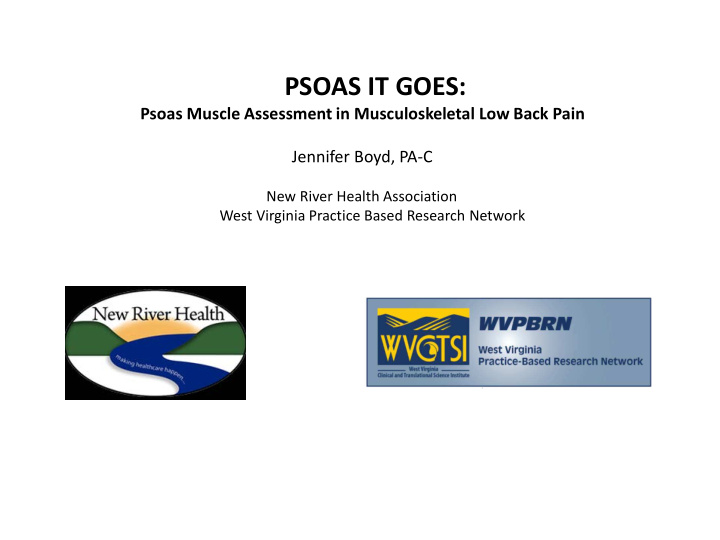



PSOAS IT GOES: Psoas Muscle Assessment in Musculoskeletal Low Back Pain Jennifer Boyd, PA-C New River Health Association West Virginia Practice Based Research Network
Financial Disclosures: None Survey Research through the WVPBRN: Information and survey included in your packet
Objectives Create awareness of psoas muscle’s role in musculoskeletal low back pain Increase awareness of psoas assessment on physical exam Increase awareness of simple psoas stretch
The Problem Back Pain: Over 80 percent of the population will experience an episode of LBP at some time during life. Recurrences of LBP are also common, with the percentage of subsequent LBP episodes ranging from 20–44 percent within 1 year for working populations, to lifetime recurrences of up to 85 percent. https://www.ncbi.nlm.nih.gov/pmc/articles/PMC4339077/ 72% of PBRN CORE survey respondents report assessing back pain at least weekly.
Psoas assessment Standard in osteopathic and chiropractic curricula Psoas Major: a case report and review of its anatomy, biomechanics, and clinical implications. (https://www.ncbi.nlm.nih.gov/pmc/articles/PMC 2796950/ ) Psoas Syndrome: A Frequently Missed Diagnosis. (https://jaoa.org/article.aspx?articleid=2094465# 73002821) 52% of PBRN CORE survey respondents had no training in psoas assessment. 74% had no subsequent training after their obtaining their professional degree.
My experience Clinical experience: lack of correlation of complaints with PE findings Training in yoga therapeutics Education on psoas assessment Integration into practice Education of colleagues https://kirkyoga.com/online-yoga-courses/
Anatomy Psoas Muscle Hip flexor and spinal support muscle. Large, thick muscle. Origin at T12-L5, passes through the pelvis, joins with iliacus, passes over the hip joint and inserts at the lesser trochanter of the femur. “Guy wire” Patients familiar with anatomy, (e.g. hunters) may know it as the tenderloin or loin. Not palpable on back exam. Palpable on abdominal exam.
Function Hip Flexion Spinal flexion and stabilization
Postural Contributors To Dysfunction Wide based stance or gait with thighs forward and out turned feet may lead to shortening, observed as decrease lumbar curve Prolonged sitting, with decreased lordosis
History Mid to low back pain, often after a history of lifting, forward flexion or prolonged sitting . “My back hurts right HERE!”
Exam: Inspection Postural patterns and cues Decreased lumbar Lordosis Thighs forward Also look at feet: often one or both are everted
Exam: Palpation Locate the point midway between the flank and the naval. Gently palpate for a firm or sore psoas. Flex hip to confirm.
Therapeutic options: Education Rest in flexion Trigger point Supine stretch Referral: PT Osteopathy Chiropractic Medication
Supine stretch instructions Iliopsoas (“ILL-E-O-SO-AS”) Muscle Stretches To Help Relieve Low Back Pain Lying down: 1. Lie on your back on a firm surface with your head down, the floor if you are able, or your bed. 2. If possible, place your feet firmly against a wall with your toes pointing straight up. (If there is not a wall for your feet, merely stretch out your legs with your toes pointing straight up.) 3. Bend your RIGHT knee and place your RIGHT foot on the floor or bed. 4. Keeping your LEFT leg straight, gently but firmly press your LEFT foot into the wall, pressing especially through the ball mound of your big toe. (If you do not have a wall, just pretend you do and firmly press the ball mound of your foot forward.) 5. Gently but firmly press your LEFT thigh toward the floor, (or bed). 6. Stretch your LEFT arm beside your LEFT ear and straighten it, like you are reaching for the wall behind you. 7. Gently press down through your LEFT foot as you reach back through your LEFT hand and fingers, creating a long stretch through the LEFT side of your body. Breathe three times slowly then release. 8. Repeat on the OPPOSITE side.
Benefits: Decreased pain: acute and chronic Patient empowerment Provider satisfaction
Thank you Please try assessment of psoas in your patients with low back pain Please join my study and let me know your experience Please feel free to contact me: Jennifer.boyd@nrhawv.org
Recommend
More recommend